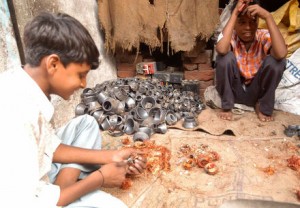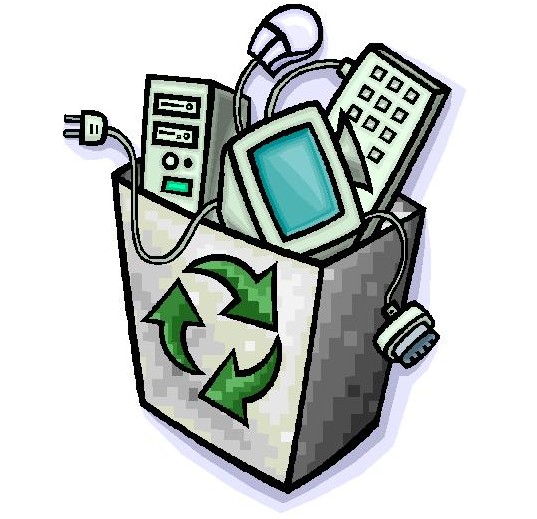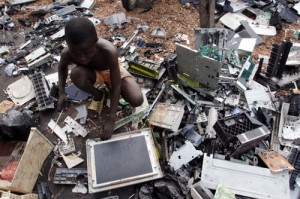Advancement in technology and development of new electronic gadgets and appliances has made our everyday life more comfortable and secure. It has made the process of accessing and acquiring information easy and time saving. The production and manufacturing of electrical and electronic equipment is one of the fastest growing global activities. Rapid economic growth, along with urbanization and an ever growing demand for consumer goods, has increased both the consumption and the production of electronic products. The Indian IT industry has been one of the major change makers in the economy and has brought about digital evolution in the country. But this whole cycle, at the same time, is creating its own toxic footprints.

What is e-waste?
E-waste is a term which incorporates almost all types of electrical and electronic equipment that could possibly enter the waste stream. Although e-waste is a general term, it covers TVs, computers, mobile phones, white goods, home entertainment, stereo systems, toys, toasters and kettles; almost any household or office item with electrical components with battery supply.
The electronic and electrical goods are largely classified under three major heads. The 3 major classification are:
- White goods – These comprise of household appliances like air conditioners, dishwashers, refrigerators and washing machines.
- Brown goods – These comprise of TVs, camcorders, cameras.
- Grey goods – These comprise of computers, printers, fax machines, scanners. But, these grey goods are comparatively more complex to recycle due to their toxic composition.
These electronic devices are complex as they are made of a wide variety of material constituents. These constituents are lead, nickel, cadmium, and mercury, which could pose risks to human health. They also contribute to environment damage at their end-of-life. Hence, it is a cause of concern to ensure proper management of these used electronics and also their correct disposal. This makes it all important to undertake the tedious work of increasing the proper collection and responsible recycling of used electronics.
The Heath risks involved
Electrical and electronic components are made of a multitude of components, some containing toxic substances that can have an adverse impact on human health and the environment, if not handled properly. The most obvious reason for the occurrence of these hazards arises from improper recycling and not adhering to the proper disposal processes used. This can have serious repercussions for those living in proximity to places where e-waste is recycled or burnt. For example, a computer contains highly toxic chemicals like lead, cadmium, mercury, beryllium, polyvinyl chloride and phosphor compounds.
Though waste from the white and brown goods is less toxic as compared with grey goods. Still it cannot be ignored completely.
Children need specific protection as they are more vulnerable to the health risks that may result from e-waste exposure. There is always a risk of hazardous chemical absorption in case of children, as their intake of air, water and food in proportion to their weight is significantly higher than that of adults. Furthermore, the functional system of their bodies such as the central nervous, immune, reproductive and digestive system is still developing and exposure to toxic substances may hamper further development, causing irreversible damage. Many children are exposed to e-waste-derived chemicals in their daily life due to unsafe recycling activities that are often conducted at their home! Some may be exposed through dump sites located close to their homes, schools and play areas.
Impact of disposing electronics into the environment without any precaution?
This new kind of waste is posing a serious challenge in disposal and recycling to both developed and developing countries. While some countries have some of the world’s most advanced high-tech software and hardware developing facilities, India’s recycling sector can be called medieval. India is known to be one of the few countries where most of the electronic products are recycled and scrap metal is generated. The Basel Convention is an international treaty which prohibits the movement of e-waste between countries. But, even after this, most of this waste is dumped into India from developed countries. The main reason behind this ongoing practice is that these developed countries find it convenient and economical to export waste and this has further complicated the problems with waste management.
An electronic product recycling is highly polluting, non-cost effective and unregulated in many countries. E-waste takes a toll on the environment. The burden of e-waste is not only that it pollutes the land-fill, but also that it has serious health implications due to chemical leaching into the water table. This eventually makes its way to agricultural produce and into people. So, what is the solution? Recycling the electronics! Recycling recovers valuable materials and as a result, we can reduce greenhouse gas emissions, pollution, save energy, and save resources of Earth.
What are the environmental benefits of reusing and recycling e-waste?
Recycling raw materials of the used up electronics is the most effective solution towards the proper management of the growing e-waste problem. Most electronic devices contain a variety of materials, including metals that can be recovered for future uses. By dismantling and providing reuse possibilities, the beauty of the natural resources is kept intact and the air and water pollution caused by the hazardous disposal is avoided. Additionally, recycling reduces the amount of greenhouse gas emissions caused by the manufacturing of new products.
Benefits of recycling is more fruitful when responsible recycling methods are used. The main aim of responsible recycling is to minimize the dangers that is brought upon by the disposed and dismantled electronics. Responsible recycling ensures best management practices for recycling the electronics and side by side worker health and safety and consideration for the environment locally as well as abroad.


Leave a Reply